Modern Japan is a country of contrasts, where high technologies are born and the behests of ancestors are honored. Likewise, the wedding ceremony in Japan combines ancient traditions and Western innovations. How the wedding ceremony takes place in the Land of the Rising Sun and how much it costs - read in our material.
The Japanese accept different religions and are calm about other religions. Therefore, weddings are celebrated here in different ways: in the Shinto style, in the Christian style and in Buddhist rites.
There is one unifying factor for all these weddings - the Japanese get married in the warmer months and have lavish ceremonies. During one wedding, the bride can change more than three outfits, and at the end of the holiday, all the guests leave with expensive gifts. Therefore, the Japanese prepare for a wedding long and carefully, collect money, invite guests 2-3 months in advance and order kimonos for rent.
As it was before
In ancient Japan, marriages were made purely for rational reasons, not for love, but to strengthen families and social status. Until the 12th century, Japanese marriages were polygamous, with men living in their wives' homes, periodically moving from one woman to another. With the advent of samurai, polygamy became a thing of the past; Japanese women began to move in with their husbands with their property, which, like herself, became the property of the man. The introduction of the newlyweds was carried out exclusively by matchmakers (nakodo), who spent a long time studying the pedigree of the families and the characters of the bride and groom. At the first meeting, the parents of both parties exchanged wedding gifts, and the matchmaker received her “dividends” after the wedding. Every year, the newlyweds gave their nakodo valuable gifts in gratitude for their acquaintance.
A little history
Until the 12th century, polygamy was common in Japan, with a husband living in each wife's house in turn. And the wedding ceremonies were very modest and were held in the husband’s house. The family became monogamous later, but the family circle also included other relatives, and often several dozen people lived in the same house. It was customary for the Japanese to honor their ancestors and their spirits, for whom they set up shrines for worship. Many of them have now turned into Shinto shrines.
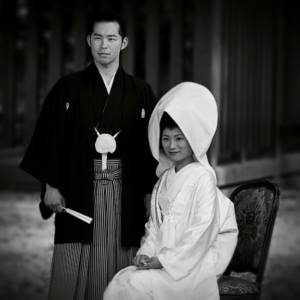
The marriageable age was 13 years for a girl and 15 for a boy. Basically, matchmaking was carried out by special people - nakodo, who received various gifts from the young people for their services. First, the newlyweds and their families had to meet at an official meeting; if they were suitable for each other, then an engagement would take place. A mandatory gift for the bride is a gold ring.
IMPORTANT TO KNOW: Engraving on wedding rings, types of engravings, ideas
Modern engagement
According to statistics, in modern Japan, 26% of couples still turn to matchmakers in memory of long-standing traditions. And although the participation of parents has not diminished, the Japanese now marry out of love and mutual consent. And engagements are held less strictly, for example, at a family dinner in a restaurant. At the festive feast, the groom gives his future wife a platinum engagement ring with a stone symbolizing the bride's month of birth. Parents exchange gifts (yuino), usually giving envelopes with money. The main expenses for the wedding are borne by the groom's parents. And if the engagement has taken place, preparations for the engagement begin.
KNOWLEDGE BASE: Wedding in Prague: organization, questions and X-day
European wedding
Most modern couples in love still marry in accordance with European traditions. If desired, a symbolic ceremony can be held according to the usual scenario: in a restaurant with a host and competitions. However, the procedure does not exclude the possibility of visiting Buddhist or Orthodox temples.
Recently, mass weddings have gained incredible popularity in Japan, when the marriage of several dozen couples is registered simultaneously. Why not take part in this unusual event?
Editor's choice: Bride ransom in an apartment: a scenario for a fun, modern tradition
Betrothal in the temple and the bride's outfit
In ancient times, a wedding took place in the man’s house; now the engagement takes place in special wedding complexes. Such palaces contain Christian churches and Shinto shrines. There are also lounges, places for photography, and restaurants and bars. Such complexes can be found at most “five-star” hotels.
Most couples are inclined towards traditional betrothal in a temple, with clear regulations and ancient rituals. Particular attention is paid to the bride's wedding dress. To get engaged, the couple rents a white kimono and a special headdress that hides the “horns of jealousy” that, according to Japanese belief, every woman has. It is almost impossible to buy such a kimono. It costs several thousand dollars because of the expensive fabric, gold and silver sprinkles, and hand embroidery. The bride will not be able to put on a kimono on her own, so she will also have to spend money on vestments. After the ceremony, the bride changes her outfit to a colored evening dress in the European style for the banquet. So in one day the bride can change clothes up to three times for different stages of the ceremony. The groom also wears a festive kimono or an ordinary classic suit.
KNOWLEDGE BASE: Wedding in Bora Bora - what is needed for this, conditions, prices, celebration scenario
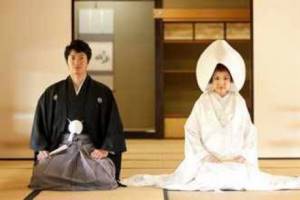
The betrothal ceremony is performed by a Shinto priest, kannushi, and an assistant, a miko. The bride enters the temple first, followed by the groom, guests and nakodo. The rite of purification of the oharai is performed and ancient prayers are read. After which the newlyweds drink consecrated sake from three bowls, three sips each, and proclaim the vows of fidelity. The ritual of drinking Divine Rice Wine is called San San Ku Do. After the first sip, the newlyweds are considered husband and wife. Then they exchange rings to the live sound of the Japanese harp (by the way, the Japanese borrowed this ritual from the Europeans). The next ritual is the dedication with holy leaves, in which the young must turn the green branches in a certain sequence. And the ceremony ends with the offering of gifts to the deity of the temple. It is interesting that the husband is the first to leave the temple, and after him the wife, confirming the primacy of the man in family matters.
Japanese people don't dance at weddings
After the engagement ceremony, guests are invited to a restaurant located next to the temple. The Japanese have no requirements for the number of guests, so a wedding can be modest - for 50-100 people, and large-scale - up to 600 guests. Guests are seated in the hall according to the degree of relationship: the nakodo sits closest to the newlyweds, then relatives and friends, and acquaintances are located at the end of the hall. All guests come to the wedding with a cash gift in an envelope, indicating the donor's initials on it in advance.
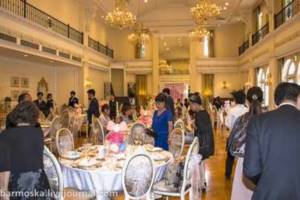
The wedding banquet is managed by the toastmaster, who not only monitors the implementation of all traditions and rules, but also prevents the use of prohibited words in congratulatory toasts. At a Japanese wedding, it is not customary to use words that imply cutting, tearing or returning anything. At the same time, young people happily accept words and gifts symbolizing happiness. Entertainment at the wedding is modest, mostly singing karaoke, and never dancing. And as the most unusual thing, the newlyweds prepare each guest a special individual gift (hakide-mono), which is presented at the end of the holiday. There is even a special catalog without prices, from which each guest can order a gift directly at the banquet. After the wedding, the newlyweds go on a trip, and only upon arrival from their honeymoon do the couple register their relationship with local authorities.
KNOWLEDGE BASE: Wedding ceremony in Morocco - an oriental fairy tale for two
LiveInternetLiveInternet

In the Land of the Rising Sun, you can observe a combination of traditions and modern technologies, which creates a unique style. The wedding customs of Japan are very different from the traditions of other countries, because most marriages are concluded by agreement - a man and a woman marry not for love, but for the sake of mutual benefit. The girl is looking for a wealthy partner, and the man is looking for a good housewife who will look after the house and raise children. Of course, in the Land of the Rising Sun, love marriages take place, the number of which is growing every year, but today there are also a lot of arranged ones.
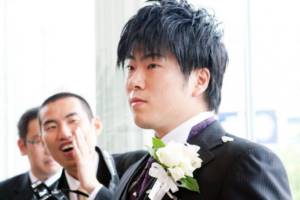
In Japan, the initiators of dating and marriage are most often women. Since ancient times, girls approached the men they liked and asked to marry them. It looked something like this: a woman sat down next to a man, smiled and expressed admiration for the sunset or admired the cherry blossoms. If the chosen one smiled back and hugged the girl, then the explanation was successful.
Girls in Japan paid attention to a man’s height, education and wealth. If there was no suitable candidate on the horizon, the girl was with any promising man. Over time, traditions in Japan have changed, and now the initiative comes from men. But since they work a lot, they most often turn to intermediaries who organize acquaintances.
Preparations for a wedding take at least 6 months, so invitations are usually sent out at least 2-3 months before the wedding. Future spouses traditionally exchange mokuroku, scrolls that list all the relatives of the other half. If the newlyweds know everyone by name, they will be able to make a good impression on the new family. In Japan, it is customary to give gifts even before the wedding. They are called engagement gifts (yuino). The groom's family gives the bride a gold or platinum diamond ring. If the family income is not high, then with a stone that matches the bride’s zodiac sign. It is also customary to give money to the bride for the wedding. Japanese weddings rarely cost less than $80,000. The bride, in turn, gives her groom a ring, but of much less value.
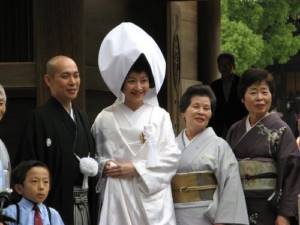
Japanese wedding ceremony. Japan has two official religions: Shinto and Buddhism. Shinto is responsible for all happy holidays. And Buddhism is responsible for rituals associated with death. This ritual has been formed over many centuries and combines ancient traditions and beliefs of Buddhist, Shinto and Christian wedding ceremonies. The bride wore a white kimono made of thick fabric, and on her head was a white silk scarf with a red tsunokakushi lining. The groom was dressed in hakama - a robe with family crests. The young people changed clothes several times during the reception, which was accompanied by a certain ritual. The details of the celebration and the pomp of the celebration depended on the financial capabilities of the groom and parents. The Japanese are not given any marriage certificates and do not make any notes in their passports (after all, the Japanese do not have an internal passport at all).
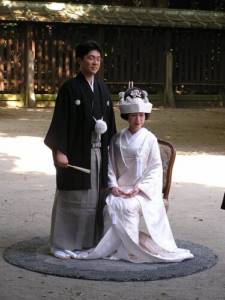
Shiro-maku (bride's wedding dress) consists of two festive kimonos. One white one, which trained women put on the bride for the wedding itself. White color is a symbol of the beginning, the bride turns from a daughter into a wife. The bride’s face must certainly be ashen white with shades of pink. As the Japanese say, “Like the gentle frost on the early slopes of Fiji, the face of a bride.” There is also a second colored kimono, most often red with gold embroidery - for a banquet. Often newlyweds decide not to buy, but to rent outfits, but this is also not a cheap matter.
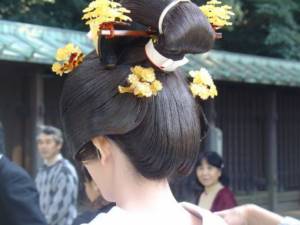
It is also customary to do a special wedding hairstyle - bunkinno takashimada. The presence of a tall wig in the hairstyle is considered mandatory. He is covered with a special scarf (tsunokakushi), which is supposed to hide small, artificial horns, symbolizing a jealous woman. And jealousy in Japan, as you know, is the biggest vice that one should be ashamed of. Warning - don’t be “horned”, that is, jealous.
Currently, the Japanese bride dresses in a white kimono, then puts on a colored outfit, after which she appears before the guests and groom in a European-style wedding attire. The bride enters the temple first, and leaves slightly behind her husband, as befits a Japanese wife. During the ceremony, the newlyweds drink from cups of sake specially prepared for this occasion three times, then swear fidelity and receive the blessing of the priest. The traditional ceremony is attended by those closest to the bride and groom, followed by a reception for friends, colleagues and relatives.
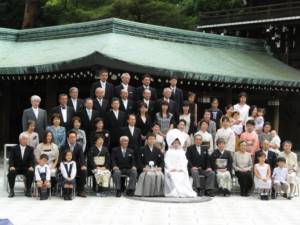
In Japan, it is not customary to decorate cars. It is also not customary to dance at a wedding; you can sing karaoke and trust the entertainment of the toastmaster. Since the costs of a wedding are extremely high, the best wedding gift here is a check or cash in an envelope (osugi). The amount ranges from 200 to 300 dollars. Relatives give up to 10 thousand dollars. The names of the donors and the amount of the gift are recorded in a book specially designed for this purpose. If the guest could not come, then he sends a cash gift by mail or through a bank. During the banquet, guests receive small souvenirs, hakide mono - most often small bouquets or sweets.
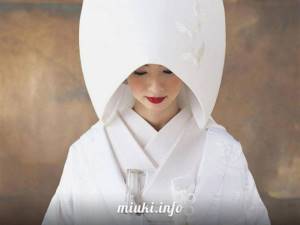
Each dish at the festive banquet is a wish for happiness and prosperity to the newlyweds. For example, clams are served with both shells on, showing that two halves make a whole, or lobster is a common guest at Japanese weddings because of its red color, which brings good luck.
Wedding tourism in Japan
Thousands of tourists visit Japan every year, and many of them come specifically for wedding tours. To cope with such demand, the Japanese have organized special wedding centers that arrange ceremonies for visiting couples in Tokyo, at the Shinagawa Jinja Temple, or in any other part of the country. For example, the latest trend in Japan is a sunflower wedding, which is held in July at the foot of the Yatsugatake Mountains, in Yamanashi Prefecture.

The services of wedding centers are not cheap - from 4,000 to 20,000 dollars. The price depends on the complexity of the bride’s outfit, the number of guests and the package of wedding services. The price does not include wedding rings, so you can bring them with you or buy them in Japan. It is better to order a wedding organization on the spot upon arrival in the country in order to rent authentic Japanese outfits and choose the best place for the ceremony. And then your wedding will definitely be the most beautiful in the world.
Parenting
Some features of raising children in Japan are well known throughout the world. For example, the fact that small children under 5-6 years old are not prohibited from doing anything, their voices are not raised at them and they are not punished at all. In this country, it is believed that the process of raising a child should be done by example - by how the mother behaves and how the father behaves. Although often, workaholic fathers communicate with their children only on weekends, and women traditionally play the role of homemaker.
Young children sleep in the same bed with their mother, who breastfeeds them on demand. Until the child reaches the age of 3 years, women, as a rule, do not work and spend their time with children.
A child's life changes dramatically from the moment he goes to school. If before this time children were allowed absolutely everything, then at school from the very first days they find themselves in a strict system of norms, rules and morality. They lay down the principles of collectivism - the primacy of common interests over personal interests, culture, etiquette and norms of social behavior.











